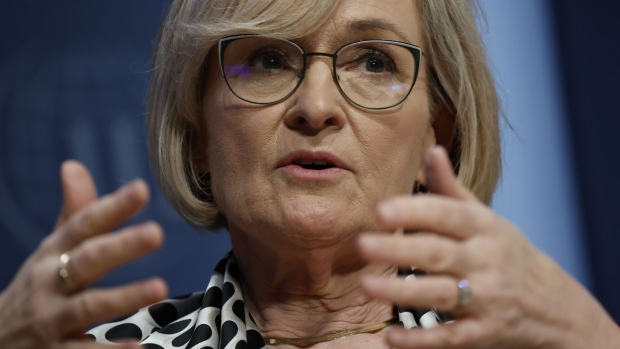Sep 19, 2023
Asset Managers Rebuffed as EU Cracks Down on Use of ‘ESG’
, Bloomberg News

(Bloomberg) -- Europe’s markets watchdog says it isn’t backing down from a controversial plan to restrict the use of “ESG” and “sustainability” in fund names, despite a barrage of criticism from asset managers.
The European Securities and Markets Authority wants asset managers to know that it won’t abandon its proposal. That’s after industry giants, including BlackRock Inc., Amundi SA and the asset management unit of Goldman Sachs Group Inc., characterized large parts of the plan as potentially unworkable in their responses to an ESMA consultation earlier this year.
“If fund managers don’t like the fact that they would have to commit to certain criteria for terms’ use in the name, they just don’t have to use those terms in the name,” Patrik Karlsson, senior policy officer for investment management at ESMA, said in an interview.
ESMA’s proposal, first unveiled in November, requires that a fund calling itself “ESG” have at least 80% of its assets promoting environmental, social and governance goals. A fund calling itself “sustainable” — or a related term — needs at least 50% of its assets to live up to that name.
Karlsson declined to say whether ESMA will stick with those exact thresholds when it unveils the final wording of its proposal as soon as the end of this month. The watchdog is “still thinking about the best way to address this,” he said. The intention is “to protect investors from situations where names are used as a marketing tool without actual substance behind it.”
Read More: How ESG Investors Are Whipsawed by Shifting Standards: QuickTake
ESG-Labeled Funds: Assets by Region of Domicile
Read More: What Lies Ahead for the ESG Fund Industry?
Europe’s goal of tying quantitative thresholds to ESG fund names has been met with intense industry opposition. In its response to the ESMA consultation, Goldman Sachs suggested the proposal ignored real-world considerations around fund management, and warned against using a “one-size-fits-all” framework.
In its consultation response, BlackRock said the plan would disadvantage managers of “fixed-income, multi-asset funds, or those active in private markets.” Amundi said the proposal made it harder to pursue strategies needed to aid the transition toward a low-carbon economy.
Lawyers advising the investment industry said earlier this year that asset managers shouldn’t assume the ESMA proposal would move ahead, in light of the “forceful and fierce” feedback. A key criticism has centered on the EU’s failure to come up with a clear definition of what it means by a sustainable investment.
The EU already has ESG fund disclosure categories. Article 8 requires that a fund’s contents “promote” ESG, while Article 9 funds must make ESG their objective and target 100% sustainable investments (with some allowance for liquidity and hedging).
Meanwhile, there’s evidence that moving ahead with the ESMA proposal could trigger widespread reclassifications across Europe’s $11 trillion fund market. The Securities and Markets Stakeholder Group, which advises ESMA, has estimated that more than 80% of Article 8 funds would have to stop using “sustainable” in their name, under the current proposal.
AUM Per SFDR Article Captured as of March 2023
That may have serious implications for fund flows. A recent study by Goldman Sachs analysts found that investment clients are increasingly targeting funds with the highest sustainability credentials, suggesting that asset managers forced to stop using “ESG” or “sustainable” in their fund names may face outflows.
Any upheaval would hit just as the market is rebounding from a bruising 2022. According to a fresh report by the European Supervisory Authorities, assets under management in EU ESG funds climbed in the six months through June to account for 20% of the total fund industry, led by constant inflows into Article 9 funds.
The investment industry has also questioned the timing of ESMA’s proposal, as it coincides with a plan by the European Commission to review the bloc’s main ESG reporting framework for asset managers, the Sustainable Finance Disclosure Regulation. Mairead McGuinness, the EU’s commissioner for financial markets and services, launched a consultation into SFDR last week, opening the door to major changes to existing ESG fund disclosure requirements.
Part of ESMA’s motivation was a need to act fast amid concerns that any efforts to rework SFDR may take several years. What’s more, ESMA made its proposal in the middle of a mass wave of fund downgrades that led retail investors to demand anti-greenwashing action from regulators. Last year, asset managers stripped the EU’s Article 9 classification off almost $240 billion worth of assets, according to estimates by Goldman Sachs, amid widespread industry confusion over how to abide by the regulation.
Meanwhile, ESMA is still considering the merits of applying a Europe-wide labeling framework to the ESG fund industry. (Some countries, including France, have already adopted such regimes nationally).
“We see merit in labeling,” Dora Blanchet, head of sustainable finance at the watchdog, said in an interview. Discussions are underway on how to design a framework ahead of a May report by EU regulators on greenwashing. But putting a system in place takes time and ESMA doesn’t have a mandate to create such a framework on its own.
“One has to look at it from the perspective of what retail investors” will look at, and that’s likely to be fund names, Blanchet said. And if there were labels, they’d probably also look at those, she said.
Read More: Almost No Funds Would Meet Proposed ‘Ecolabel’ in ESMA Review
(Updates with comment on labels in final paragraphs.)
©2023 Bloomberg L.P.






